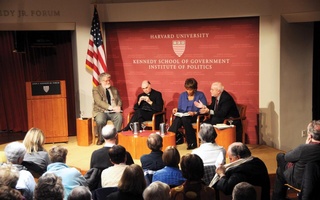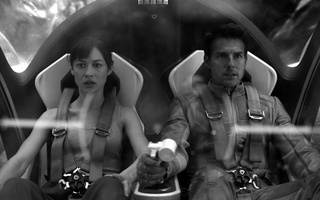
Wally Winthrop (Abbie Cornish) walks through a rainy New York City dreaming of her idol, Wallis Simpson (Andrea Riseborough) in Madonna’s new film, “W.E.”
“W.E.,” a new movie about a historical love story, is the confused brainchild of scriptwriter and director Madonna. You may have heard of her: singer, songwriter, dancer, producer, designer, author, philanthropist, and Kabbalist. However, there is a reason you rarely hear about her directing endeavors, and it is not because her Super Bowl performances overshadow them.
Her first directorial flop, “Filth and Wisdom”—more filth than wisdom— solidified her negative reputation for filmmaking. It is clear that she hoped to win critics back with “W.E.” but neither the big budget nor the big hopes could save this movie, an inappropriate comparison between an interesting moment in history and a modern-day flake.
Like the product of an overambitious mash-up artist, “W.E.” details the familiar affair of King Edward VIII and American divorcee Wallis Simpson, and then intersperses it again and again with an unrelated, unsympathetic scenario until what we love about the infamous tryst is utterly unrecognizable. Madonna counterposes the royal story of Edward (James D’Arcy) and Wallis (Andrea Riseborough) with a modern-day romance starring Wally Winthrop (Abbie Cornish), a stylish but simpering New Yorker stuck in an abusive relationship.
The two plotlines have seemingly nothing in common, which is why it is bizzare that Madonna so forcefully intertwines them. The absence of plot is palpable as the film constantly shuttles between time periods. After 15 minutes, the remix becomes an unceasing headache.
If the film has any continuity it is the theme of errant violence—violence done to the characters and to the viewers—coursing through an otherwise weak script. Madonna chooses to focus on what she saw as the underreported tragic circumstances of Wallis’ life of scandal. “Everyone always talks about what he gave up to be with her, but no one ever thinks about her,” protests Wally in a whiny, flat voice. The young Wally—the unfortunate victim of a violent, deceitful husband—likes to think that the famous Wallis Simpson is watching over like a fairy godmother, despite the obvious differences in their situations.
While the original Wallis had to face a restrictive society, Wally gets roughed up and passed up by the potentially adulterous man she married, yet desperately insists on bearing his child in hopes of making him stay. It is the classic tale of delusion and female subjugation. However, other than a general theme of trials of will and resistance, it bears no resemblance to Wallis’ struggle to legitimize her love in the face of a scathing press and an inflexible monarchial tradition. Hence, Wally’s inexplicable obsession with the royal couple makes her situation look even more desperate than she already is.
As in most of her work, Madonna tries to cast this as a feminist statement against a male-dominated society. The film’s internal look at women’s silent suffering behind public scrutiny or domestic violence is ripe with potential for an immediate raw reaction, but “W.E.” kills it before it can develop into something interesting. Every scene fades into the next before any real character progress or depiction of emotional depth can gain traction. Instead of delivering any powerful lasting messages, the camera shakily skids across the surface leaving the viewers to do all that they can: watch a sort of superficial fashion show taking place.
The film is most memorable for its decadent displays of wealth and luxury, which is the currency of many period pieces. The setting of the dualistic story is a Sotheby’s auction that allows for a parade of Cartier jewelry and vintage accessories. Other highlights include the eighty-something designer dresses worn by Riseborough, who brings Wallis Simpson to life in the only talented performance in the film. Save for her acting, it will come as no surprise that the few enjoyable moments in the movie involved spontaneous bursts into sexy dance paired to incongruous pop music. That’s the Madonna we know and love! But for that we do not to trek to the big screen. YouTube will suffice.
Unfortunately, instead of embracing the real allure of the drama, its old-world glamour, Madonna feels the need to overwrite and atone for it by adding an unrelated sob story. Rather than embrace its fun-loving flirtatiousness, the film struggles to become something more—an inspirational story about finding true love, a serious documentary about uncovering truth, a life lesson about changing one’s destiny—and crashes and burns in this muddled attempt.
Read more in Arts
Journey 2 the Hackneyed NightmareRecommended Articles
-
 Evangelist Panel Discusses Religion in Politics
Evangelist Panel Discusses Religion in Politics -
Allston Students Face Two WorldsHolm, from Allston, says there has developed a dissonance between loving her school and having a deep personal knowledge of the impact it has had on her neighborhood.
-
 Top Five Places to Find Jazz in Boston
Top Five Places to Find Jazz in Boston -
 Tweets Of The Southern Wild
Tweets Of The Southern Wild -
HKS Panel Encourages Religion in the Public SphereChristian author Jim Wallis and Memorial Church Minister Jonathan L. Walton argued that the public should harness the power of religion to pursue the “common good” in politics on Monday in an event hosted by the Harvard Kennedy School’s Center for Public Leadership.
-
 Visuals Breathe Life into “Oblivion”
Visuals Breathe Life into “Oblivion”













